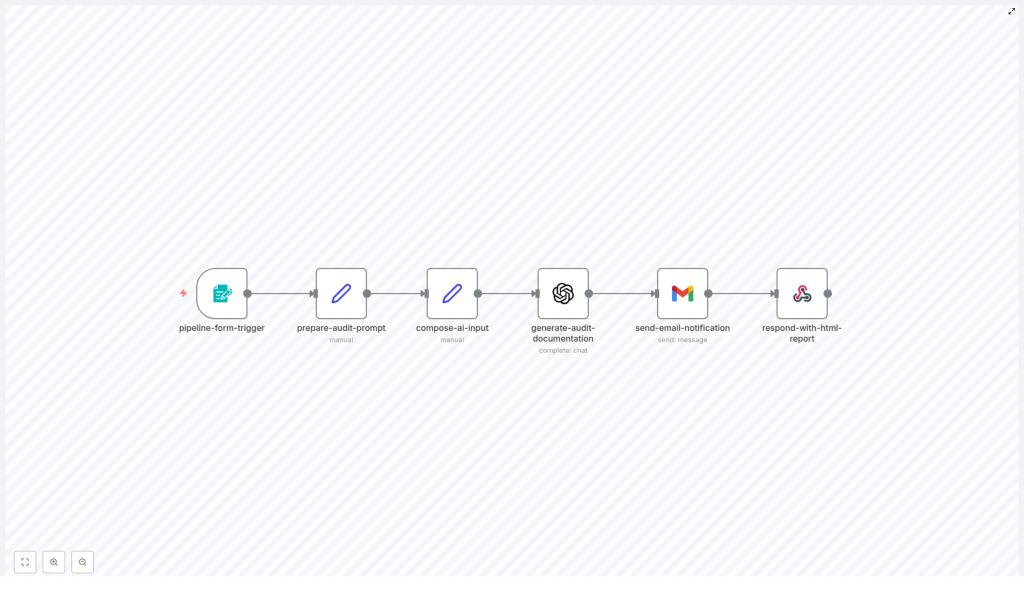Build a CI/CD Pipeline Auditor with n8n & AI
Automate pipeline documentation and audits using n8n, OpenAI, and email notifications. This guide walks through the workflow, setup, and customization.
Introduction
Keeping CI/CD pipelines documented and auditable is a recurring pain point for engineering teams. Manual reviews are slow and inconsistent, while missing documentation increases onboarding time and operational risk. This guide explains how to build an automated CI/CD Pipeline Auditor using n8n and an AI model (OpenAI) to generate concise, actionable documentation and deliver it via email and a web report.
What this workflow does
The sample n8n workflow accepts a pipeline configuration file via a form, sends the file to an AI model for an audit-style summary and documentation, emails the result to a stakeholder, and returns an HTML report. Expected outcomes include:
- Clear, structured audit documentation for a CI/CD pipeline
- Email notification to a designated recipient
- An HTML report viewable from the webhook response
- Customizable prompts and templates for team preferences
Workflow overview (node-by-node)
1. pipeline-form-trigger
This node exposes a webhook-based form where users paste the pipeline file, provide the pipeline name, select the pipeline type (GitHub Actions, GitLab CI, Jenkinsfile, Azure Pipelines, or Other), and supply a notification email. Use this as the ingest point for manual or automated audits.
2. prepare-audit-prompt
This node constructs a deterministic, well-structured prompt for the AI model. It contains guidelines for the audit: who the pipeline is for, the use case, pipeline overview, expected outcomes, setup steps, customization tips, and security recommendations. Designing a clear prompt yields consistent, high-quality documentation from the AI.
3. compose-ai-input
compose-ai-input merges the form inputs with the prepared prompt. It packages the pipeline name, type, and full configuration file into a single input string so the model can analyze the content and produce an audit report tailored to the provided pipeline.
4. generate-audit-documentation (OpenAI)
This OpenAI node calls the chat model (e.g., GPT-4) with the combined input. Recommended settings: temperature 0.2–0.7 for reliable output and a high max token limit to allow comprehensive documentation. The node returns the generated audit text.
5. send-email-notification
Once the audit is generated, this node sends an HTML email to the notification address from the form. Include a summarized header and the full audit content in a readable layout. This enables stakeholders to receive documentation without visiting the webhook URL.
6. respond-with-html-report
The final node responds to the original webhook request with a polished HTML report. This is useful when the form is used directly in a browser or embedded in documentation portals. The report can include the generated content and a timestamp.
Setup & prerequisites
Before deploying the workflow, ensure you have:
- An n8n instance (cloud or self-hosted)
- An OpenAI API key configured in n8n credentials
- Email credentials or OAuth set up for the Gmail node (or any SMTP provider)
- Access control for the webhook endpoint (optional but recommended)
Secrets and access
Store credentials in n8n’s credentials store. Do not embed secrets in prompts or logs. If your pipeline file contains secrets (tokens, private keys), instruct users to redact them before submission or add automatic redaction steps to the workflow to avoid leaking sensitive information to the AI service.
How it works — expected outputs
The generated audit will typically include these sections:
- Who is this pipeline for?
- What problem does it solve / Use case
- Pipeline overview (triggers, jobs/stages, key steps)
- Environment variables and secrets referenced
- Expected outcomes (artifacts, deployments, notifications)
- Setup & rollout instructions
- Customization tips
- Security & compliance considerations
This structure is controlled by the prompt template in the prepare-audit-prompt node. You can modify that template to suit your organization’s documentation style or compliance needs.
Customization ideas
- Automated redaction: Add a step to detect and mask secrets (API keys, tokens) before sending content to OpenAI.
- Webhook triggers: Integrate with repository platforms (GitHub/GitLab webhooks) to automatically submit pipeline files on changes.
- Multi-channel notifications: Send summaries to Slack, Microsoft Teams, or create tickets in Jira for audit findings.
- Quality gates: Extend the prompt to include checks for tests, scanning, and manual approvals — and fail the run if critical items are missing.
- Versioned reports: Save generated documentation to a central repository or object store (S3) for historical audit trails.
Security & compliance considerations
AI-assisted workflows that process configuration files can expose sensitive information. Apply these safeguards:
- Redact secrets before sending to third-party APIs
- Use role-based access to the n8n form and webhook
- Keep audit logs and store generated reports in a secure, access-controlled location
- Document data retention and ensure compliance with your organization’s policy for PII and secrets
Rollout checklist
- Deploy n8n and configure OpenAI credentials
- Create and secure the webhook/form and validate access control
- Test with a non-sensitive pipeline file and verify the email & HTML report
- Add redaction or consent messaging for pipelines that may contain secrets
- Iterate prompt and templates based on stakeholder feedback
Example prompt (trimmed)
"""
Analyze the provided CI/CD pipeline file and produce concise, actionable documentation for DevOps stakeholders.
Include: who is this for, what problem it solves, pipeline overview, expected outcomes, setup instructions, customization tips, and security considerations.
"""
Final tips
Start with a low-risk rollout: only allow internal users to submit pipelines and require redaction. Monitor outputs for consistency and tune the prompt for your environment. Over time you can expand the workflow to enforce compliance gates or auto-create change requests when a pipeline lacks critical steps.
Call to action: Try deploying this workflow in a staging environment today. If you want a copy of the n8n workflow or help customizing prompts for your stack, contact the DevOps automation team or reply to this post to request support.

